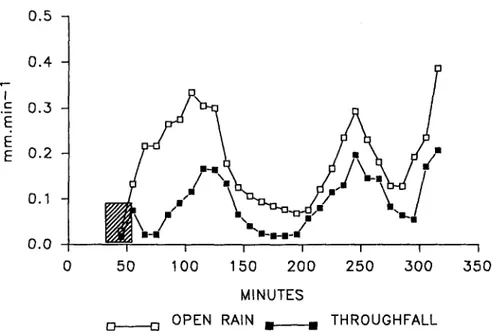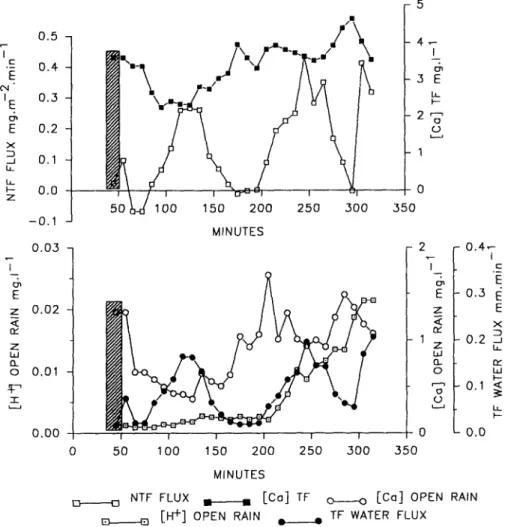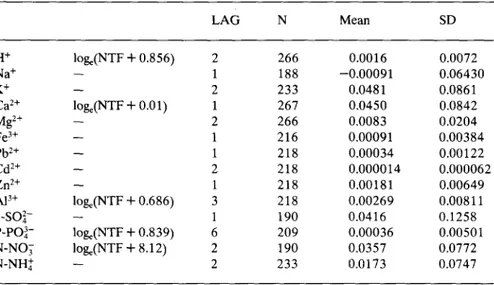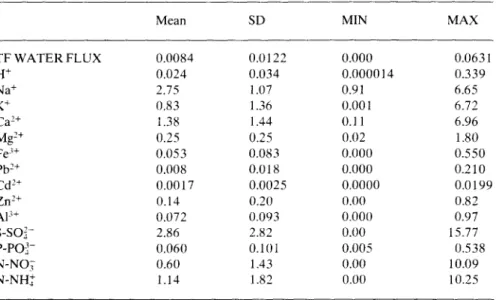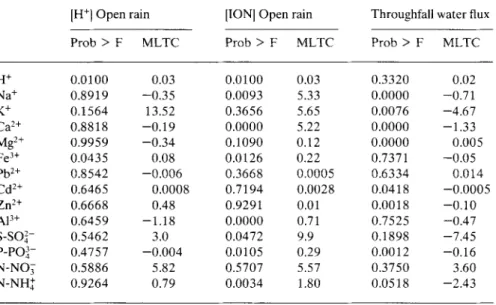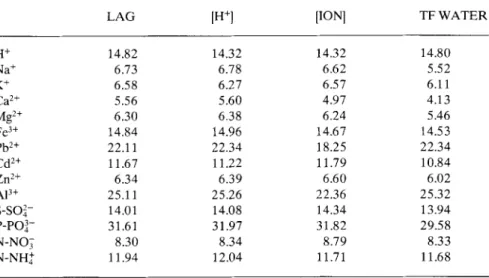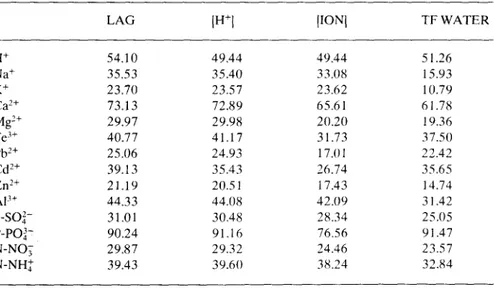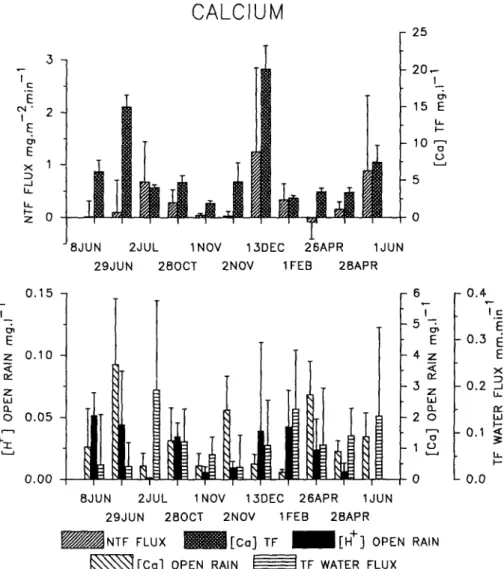Relative importance of factors controlling the leaching and
uptake of inorganic ions in the canopy of a spruce forest
A. HAMBUCKERS & J. REMACLE
Microbial Ecology, University of Liege, B22 Sart Tilman, 4(X)0 Liege, Belgium Received 17 December 1991; accepted 29 September 1993
Key words: canopy leaching, canopy uptake, ionic diffusion, ionic exchange, Picea abies,
throughfall
Abstract. Sequential sampling of precipitation under mature spruce trees and time-series
analysis of the data were performed in order to assess, in natural conditions, the relative importance of different factors that could influence the leaching and uptake of inorganic ions in the canopy. Eleven rain events were analyzed in order to estimate how external factors, rain intensity, H+, and ionic concentration of the incident rain influence the ionic throughfall concentrations and the net throughfall fluxes.
The results led to the conclusion that leaching or uptake mostly occur by diffusion. The influence of the open rain acidity was not conclusive; however, it was shown that the tested external factors only controlled a few percent of the variation of the data. By contrast, the autocorrelation of the data always explained a large portion of the variance. It could result from the gradual changes in the course time of internal factors related to the exchange system including waxes, cuticles, apoplast and xylem sap. These constituents were known to control the exchange at the canopy surface and to be sensitive to the plant physiology and environmental conditions.
Introduction
The chemical composition of throughfall results from the alteration of the composition of the rain water as it passes through the forest canopy. Two mechanisms govern the nutrient exchange at the canopy surface: (1) the dissolution and wash-off of the faeces of birds and insects, of deposits originating from the atmosphere and of substances secreted by the trees prior to the wetting event and (2) the exchange of material occurring between plant tissues and external water.
Various methods have been used to estimate the leaching-uptake rate in forests: radiolabelling of the pool of substances under study by injection into the stem, followed by determination of the foliar specific activity, collection of throughfall and estimation of dry deposition by isotope
dilution (Garten et al. 1988; Lindberg & Garten 1988); mathematical modeling of the throughfall composition following sequential sampling in the course of individual rain events (Olson et al. 1985; Johannes et al. 1986; Schaeffer et al. 1988; Lovett et al. 1989) or after single or multiple rain event sampling (Lovett & Lindberg 1984; Stachurski 1987; Puckett 1990); canopy exchange budgets with leaching-uptake rate being com-puted as throughfall minus the estimated rates of wet and dry deposition (Lovett et al. 1985; Lovett & Lindberg 1986; Fahey et al. 1988; Beier & Gundersen 1989). These methods demonstrate that the contribution of leaching and uptake to throughfall was very significant and dependent on ions, trees species, and seasons.
The exchange of ions between the surface and interior of the tree may occur through leaves and bark. For intact leaves, in the absence of a surface tension agent in the incident water, stomatal penetration by aqueous solutions should be only of minor influence (Schaefer & Reiners 1989), confirming the preponderance of transcuticular exchanges. The external surface of bark is less resistant to liquid phase and ionic diffusion than cuticle but much smaller surface areas reduce the potential effect of bark on throughfall chemical processing (Katz et al. 1989; Schaefer & Reiners 1989).
In forests, the concentrations of several dissolved ions in the surface water were found to control their exchange fluxes with the canopy (Olson et al. 1985; Schaeffer et al. 1988; Lovett et al. 1989; Foster 1990; Wilson 1992). Mecklenberg et al. (1966) demonstrated that the source of Ca2 + leached from bean plants is not derived from the cell interior. Numerous reports show that low pH water increases the rates of cation leaching and the neutralization of acidity, although sometimes it may diminish the rates of uptake (Wood & Bormann 1975; Adams & Hutchison 1984; Kelly & Strickland 1986; Paoletti et al. 1989a; Paoletti et al. 1989b; Schier 1987; Kaupenjohann et al. 1988; Foster 1990; Muir 1990; Scherbatskoy & Tyree 1990; Turner & Tingey 1990). The cation leaching could be explained by the exchange with H+, whereas physical damage by the strong acidity to the foliar cuticle or to the underlying cells is also possible and could result in an increase in anion leaching (Percy & Baker 1988). In addition, Lovett et al. (1985) contend that organic acids may be important counter ions to cation leaching.
Therefore, three main mechanisms are thought to control the rate and the direction of the canopy exchange: (1) diffusion along concentration gradients, (2) ion exchange, and (3) physical damages by strong acidity.
The present study evaluates, in natural conditions, the relative impor-tance of different factors that could influence the leaching and uptake of inorganic ions from the foliage of mature spruce trees (Picea abies L.
Karst.). It was based on a time series analysis of data collected by the sequential sampling of several rain events.
Material and methods
The experiments were conducted in the course of 1989 and 1990 under 60-yr old spruce trees (Picea abies L. Karst.) in a stand close to the watershed 'La Robinette' located in Haute Ardenne, Belgium at about 500 m above sea level. Annual rainfall is about 1300 mm, and the annual average air temperature is 7 C. Detailed site characteristics were given in Buldgen et al. (1984) and Hambuckers & Remacle (1991).
A total of 18 events were sampled, but 7 were rejected because the rain was too intermittent to perform accurate statistical analysis. The incident rain was collected 150 m from the spruce stand, in the middle of a 2-ha open area, using a self-designed system excluding the dry deposition. Sixteen 24-cm-diameter polyethylene funnels were mounted on a table and connected together with tygon tubing to a collecting vessel. A rain detector provoked the shifting of a shutter covering the funnels and a record of the time of the rain event. The rain detector was moderately heated by electrical resistances to avoid activation by dew or mist. The collection of about 100 ml of rain commuted stainless steel electrodes located in the collecting vessel. This activated an automated ISCO sam-pler, which recorded the time of the beginning of sampling. The water was then pumped at intervals of 10 minutes in distinct vessels during the next 280 minutes.
The throughfall was collected by the use of 16 funnels. The funnels were mounted on 1 to 2 m wooden stacks pitched near the trunk of 6 trees and connected together to a collecting vessel. As the objective of the experimentation was to study the effect of rain intensity and composition on throughfall composition, we attempted to record the maximum influ-ence of the canopy by collecting throughfall under its most dense part. The funnels were covered with a nylon cloth to exclude needles, bud scales, insects and other organic debris from the collection vessels; the material that accumulated on the cloth was scrubbed between each rain event. The water was pumped with a second automated sampler switched on by the system activating the open rain sampler. Both collection systems were rinsed with diluted HC1 and distilled water prior to assemblage and were tested for potential contaminants. Several cleanings were made during the year of sampling. Successive samples were pooled together for analysis when sample volume was less than 15 ml; it was then assumed that the concentration was the same in each one of the pooled samples.
Samples were gathered within a couple of days and stored in the dark at 4 C. They were analyzed within the next two weeks for pH and after filtration for the following ions Ca2+, Mg2+, K+, Fe3+, A13+, Pb2+, Cd2+, Zn2+, Na+, NH+, NO3, SO42- and PO3 -. NH+ and PO3 - were assessed by colorimetry (APHA 1980), NOy and SO4- by anion chromatography (Polyspher ICAN-2 Merck column, mobile phase of 4 mM salicylate at pH 7.8, indirect UV-detection at 254 nm), and the metallic cations by flame or graphite furnace spectrophotometry (Perkin Elmer 2800 spectro-photometer with HGA 400 unit). Since rain and throughfall were dilute solutions, proton concentration (mg/l) were computed as 1000* 10-pH .
Two sets of data were subject to statistical analysis: (i) ionic throughfall concentrations and (ii) ionic net throughfall fluxes, these latter values being computed as bulk throughfall deposition minus open rain deposi-tion. It was assumed that the data formed a time series of constant variance, with missing values between successive events. In the course of each event, when no rain or throughfall was collected, the concentrations were kept to their last assessed values. while the water flux was set to 0. The distributions were examined for normality with Kolmogorov's test, stem leaf plot, and normal probability plot (SAS 1985). Sample autocorre-lation was examined using the Durbin-Watson d test (Durbin & Watson 1951). In case of autocorrelation, the data were regressed by least square estimates against their successive lagged values until the Durbin h test or its alternative (Durbin 1970) was not able to detect any autocorrelation of the residuals.
The influence of the ionic concentrations in rainfall and of the water flux on the throughfall quality was investigated using the concept of Granger causality (1969). In Granger's theory, a variable causes another variable; that is, the values of one variable improve one's ability to predict the future values of another variable (Holland 1986). The use of the words to cause and causality refers to this definition.
The following model was adjusted using least square estimates:
Y, = ai Yti + bjX,_j+ ct + Et
Yt is the dependent variable, ai were the coefficients of the lagged values
of Y with i > 0, bj the coefficients of X, the present and lagged values of the causal factor, j being 0 to 2, ct a linear function of time and et the residuals. The causality significance of X was estimated by testing the null hypothesis (HO) at the 5% level:
This was done by computing the residual sum of squares of the model in the unconstrained form (RSSU) and under Ho(RSS). The significance of the increase of RSSc was tested following Amemiya (1973):
F(m, T- k) ((RSSc - RSS)/I)/(RSSu/(T - k))
where F(j, T - k) converges to Fisher's (j, T - k) distribution, j was the number of effects of the causal factor, T the number of observations, and k the total number of coefficients to be estimated. An estimate of the causality was given by the mean long-term causality (MLTC) computed as:
ML TC = L TCC.Xm
Xm being the mean of the causal variable and LTCC the long-term causal coefficient (Gourieroux & Monfort 1990) computed from the coefficient determined in the unconstrained models with the untransformed series:
LTCC = b/(l - E a,).
For example, if the throughfall water flux is assumed to be constant and equal to its mean value in the course of all the events, then the causality of this factor upon one dependent variable would be ML TC.
Estimates of the importance accounted for by the autocorrelation and the causal variables on the variability of the dependent variable were given by the comparison of the variance of the residuals expressed as percentage of the variance of the transformed series.
Results and discussion
Throughfall samples as well as open rain samples were collected sequen-tially with the aim of studying mechanisms of uptake and leaching, in relation to incident rain composition and water flux. Lindberg & Lovett (1985) have demonstrated that dissolution of most surface-deposited material occurs within 3-4 minutes after the leaves are wetted. Thus, we expected, as Olson et al. (1985), that any dry deposition effects would be manifest only in the first minutes of the rain events we sampled. In fact, the collection of the first throughfall samples took between 10 and 232 minutes for depths varying between 0.007 mm and 0.157 mm. The depth of the open rain simultaneously collected varied between 0.227 and 1.717 mm. These large variations were attributed to differences in the
meteoro-logical conditions prior the events and to variations in the rain intensity. In many circumstances, no throughfall was collected after the collection of the first 100 ml of open rain which activated the samplers. In any case, a large amount of water reached the canopy during the periods of collection of the first throughfall samples, which would permit the dissolution of any
dry deposits.
We initially counted on information gathered by a precipitation re-corder located 3.5 km from the experimental site to record the events occurring between our samplings and to analyze the effects of the ante-cedent conditions. However, discrepancy between both locations due to the high temporal variation of the rain made it necessary to obtain on site inter-events data. For this reason, the first sample of throughfall of each event was discarded from subsequent statistical analysis.
There was little or no time lag between incident precipitation and throughfall, indicating a canopy residence time for water that was less than the interval between samples (Fig. 1). This was confirmed by instan-taneous causal link between incident fall and throughfall. We concluded that once the canopy is wet, water transfer occurs within a negligible period when compared to the 10-minute sampling periods. Therefore, it
r% l; U. 0.4 .E 0.3 E E 0.2 0.1 0.0 0 50 100 150 200 250 300 350 MINUTES
, .o OPEN RAIN ~ THROUGHFALL
Fig. 1. Evolution of the throughfall and open rain water fluxes in the course of the 28th April rain event (crosshatched data were removed for the statistical analysis).
was assumed that the net throughfall ionic fluxes reflected the evolution of actual canopy output-input budget. Typical sequential data are given in the Fig. 2 for Ca2+ in the course of the April 28th event; the values of the causal variables are also mentioned.
The normality of the data was generally improved by log transforma-tion before statistical analysis (Table 1 and 2). Every time series exhibited strong serial dependence, as attested by the number of lag values taken into account and the reduction of the residual variance (Table 2).
0.5 0.4 0.3 0.2 0.1 0.0 -0.1 0.03 0.02 0.01 0.00 MINUTES 14 3E I-2 1 (J 2 I-E z a, 1 z W a-o 0 0 0 - 0.4-C E 0.3 E E -0.2 B Ua W -0.1 < LL - 0.0 0 50 100 150 200 250 300 350 MINUTES
NTF FLUX [Ca] TF o o [Ca] OPEN RAIN
E- ,n [H+] OPEN RAIN * TF WATER FLUX
Fig. 2. Evolution of the net throughfall flux (NTF flux) and throughfall concentration (TF) of Ca2 +, H+ open rain concentration, Ca2+ open rain concentration and throughfall water flux (TF water flux) in the course of the April 28th rain event (crosshatched data were removed for the statistical analysis).
c E C. IE E x -j ULL z c E z z UJ T < A;
Table I. Transformation of the throughfall ionic concentration data, number of lag values to remove autocorrelation (LAG), number of observations (N), mean (mg.1- ') and standard deviation (SD). LAG N Mean SD H+ pH 1 261 0.26 0.57 Na+ loge 2 181 5.40 2.34 K+ loge 1 233 7.77 7.67 Ca2 + loge 4 257 6.81 5.76 Mg2+ loge 1 260 1.40 1.06 Fe3 + log 1 221 0.24 0.36 Pb2 + loge 1 222 0.044 0.053 Cd2 + loge 2 221 0.0053 0.007 Zn2+ log, 2 220 0.49 0.65 Al+ loge 3 216 0.43 0.35 S-SO2- loge 2 194 13.76 16.65 P-PO3- - 2 207 0.22 0.62 N-NO3 loge 1 196 4.73 5.40 N-NH4 loge 1 238 3.82 5.06
Table 2. Transformation of net throughfall values (NTF), number of lag values to remove autocorrelation (LAG), number of observations (N), mean (mg.m-2.min- 1) and standard deviation (SD). LAG N Mean SD H+ loge(NTF + 0.856) 2 266 0.0016 0.0072 Na+ - 1 188 -0.00091 0.06430 K+ - 2 233 0.0481 0.0861 Ca2+ loge(NTF + 0.01) 1 267 0.0450 0.0842 Mg2+ - 2 266 0.0083 0.0204 Fe3 + - 1 216 0.00091 0.00384 Pb2 + - 1 218 0.00034 0.00122 Cd2+ - 2 218 0.000014 0.000062 Zn2+ - 1 218 0.00181 0.00649 Al3 + log(NTF + 0.686) 3 218 0.00269 0.00811 S-SO- - 1 190 0.0416 0.1258 P-PO4- log,(NTF + 0.839) 6 209 0.00036 0.00501 N-NO7 log,(NTF + 8.12) 2 190 0.0357 0.0772 N-NH+ - 2 233 0.0173 0.0747
Three causal factors were tested against the throughfall ionic concen-trations and the net ionic throughfall fluxes: (1) throughfall water flux, (2) open rain concentration of each ion on its throughfall value and (3) H+
open rain concentration. The characteristics of these factors are sum-marized in Table 3. Causality inference is given in Table 4 for the throughfall concentrations and in Table 5 for the net throughfall fluxes.
Throughfall water flux significantly caused the concentration of Na+, K+, Ca2 +, Mg2+, Cd2 +, Zn2 +, and PO3 -. MLTC showed a negative link,
except for Mg2 +. Throughfall water flux positively caused the net through-fall ionic fluxes, except for PO3-. The open rain concentration of H+, Na+t, Ca' , Fe3+, A13+, SO2-, PO3- and NH+positively caused their throughfall concentration. The open rain concentration of H+, Na+, Ca2+, Mg2+, Fe3+, Cd2+, Zn2+, A3+, SO4-, NO3 and NH4 negatively caused their net throughfall flux, while the open rain concentration of Pb2 + and
PO4-positively caused their net throughfall flux.
Most of these results were in accordance with earlier studies based on single or on multiple event samplings (Parker 1983). The positive influ-ence of the open rain concentrations on their throughfall concentration may be due to evaporative concentration of the intercepted water. The positive influence of the precipitation depth on the net throughfall ionic fluxes and its negative influence on the throughfall concentrations is probably due to an increase in the nutrient leaching from the canopy. Our results also support the hypothesis that the exchange of material between plant tissue and impinging precipitation occurs by diffusion. Several
Table 3. Mean, standard deviation (SD), minimum (MIN) and maximum (MAX) values of the causal variables, throughfall water flux (TF WATER FLUX, mm.min-'), H+and ionic concentrations of the open rain (mg.l-') that were tested against the throughfall ionic concentration and net throughfall data.
Mean SD MIN MAX
TF WATER FLUX 0.0084 0.0122 0.000 0.0631 H+ 0.024 0.034 0.000014 0.339 Na+ 2.75 1.07 0.91 6.65 K+ 0.83 1.36 0.001 6.72 Ca2+ 1.38 1.44 0.11 6.96 Mg2+ 0.25 0.25 0.02 1.80 Fe3+ 0.053 0.083 0.000 0.550 Pb2 + 0.008 0.018 0.000 0.210 Cd2+ 0.0017 0.0025 0.0000 0.0199 Zn2+ 0.14 0.20 0.00 0.82 A13+ 0.072 0.093 0.000 0.97 S-SOi- 2.86 2.82 0.00 15.77 P-P0- 0.060 0.101 0.005 0.538 N-NO3 0.60 1.43 0.00 10.09 N-NH+ 1.14 1.82 0.00 10.25
Table 4. Effects of H+ open rain concentration, ionic open rain concentrations and throughfall water flux on the ionic throughfall concentrations. Probability to observe a larger F under null hypothesis (Prob > F) and mean long term causality (MLTC, mg.l-').
[H+}Open rain Prob > F MLTC 0.0100 0.03 0.8919 -0.35 0.1564 13.52 0.8818 -0.19 0.9959 -0.34 0.0435 0.08 0.8542 -0.006 0.6465 0.0008 0.6668 0.48 0.6459 -1.18 0.5462 3.0 0.4757 -0.004 0.5886 5.82 0.9264 0.79
[ION] Open rain Throughfall water flux Prob > F MLTC Prob > F MLTC 0.0100 0.03 0.3320 0.02 0.0093 5.33 0.0000 -0.71 0.3656 5.65 0.0076 -4.67 0.0000 5.22 0.0000 -1.33 0.1090 0.12 0.0000 0.005 0.0126 0.22 0.7371 -0.05 0.3668 0.0005 0.6334 0.014 0.7194 0.0028 0.0418 -0.0005 0.9291 0.01 0.0018 -0.10 0.0000 0.71 0.7525 -0.47 0.0472 9.9 0.1898 -7.45 0.0105 0.29 0.0012 -0.16 0.5707 5.57 0.3750 3.60 0.0034 1.80 0.0518 -2.43
Table 5. Effects of H+ open rain concentration, ionic open rain concentrations and throughfall water flux on the net throughfall fluxes. Probability to observe a larger F under null hypothesis (Prob > F) and mean long term causality (MLTC, mg.m-2.min-l).
tH+] Open rain lION] Open rain Throughfall water flux Prob > F MLTC Prob > F MLTC Prob > F MLTC H+ 0.0000 -0.00073 0.0000 -0.00073 0.0008 0.0015 Na+ 0.9981 -0.01534 0.0015 -0.05022 0.0000 0.03786 K+ 0.2479 -0.00107 0.2991 -0.01585 0.0000 0.0283 Ca2+ 0.2782 0.00031 0.0000 -0.04976 0.0000 0.0453 Mg2+ 0.7705 -0.00220 0.0000 -0.01196 0.0000 0.0118 Fe3 + 0.7698 -0.00028 0.0000 -0.00097 0.0001 0.00091 Pb2 + 0.0889 -0.00025 0.0000 0.00007 0.0000 0.00073 Cd2 + 0.0000 0.000002 0.0000 -0.0000009 0.0001 0.000009 Zn2 + 0.0203 -0.000023 0.0000 -0.00521 0.0000 0.00274 A13+ 0.2342 0.00083 0.0038 -0.00037 0.0000 0.00346 S-SO2- 0.1079 0.0544 0.0002 -0.05374 0.0000 0.0542 P-PO3- 0.6830 -0.000038 0.0000 0.00011 0.8264 -0.00002 N-NO3 0.4598 0.02007 0.0000 -0.00335 0.0000 0.0329 N-NH+ 0.5682 -0.00383 0.0207 -0.05686 0.0000 0.0219 H+ Na+ K+ Ca2 + Mg2 + Fe3 + pb2+ Cd2 + Zn2+ Al3+
S-SO2- p-PO3-N-NO3 N-NH+authors have suggested that the diffusion is controlled by the quotient of the concentration gradient between external and apoplastic solutions and a resistance term related to the canopy component surfaces (McFarlane & Berry 1974; Luxmoore et al. 1978; Hamilton et al. 1982; Olson et al. 1985; Lovett et al. 1989). The throughfall water flux and the ionic concentrations of the open rain may be factors controlling the concentra-tion of the plant surface water and consequently they should act on the concentration gradients between plant surface water and apoplast. For example, suppose that the efflux of one ion from the foliage decreases when its concentration in the plant surface water, i.e. the concentration of the open rain, increases; the consequence of this would be a lowering of its net throughfall flux but an enhancement of its throughfall concentra-tion, as a result of the evaporative concentration effect.
The H+ concentration in the open rain positively caused the Fe3 + throughfall concentration and the Cd2 + net throughfall flux, but it nega-tively caused Zn2+ net throughfall flux. Numerous studies have reported that H+ addition in precipitation increased the leaching rate of cations or diminished their uptake rates. This is usually interpreted as cation ex-change with H+. There may also be critical acidity values, varying with plant species, over which physical damages to the waxes, cuticles or the underlying cells occur. In such conditions, the exchange flux of cations (Wood & Bormann 1975; Foster 1990) and anions (Evans et al. 1981; Evans et al. 1985; Percy & Baker 1988) could be enhanced. We noted that all the open rain H+ concentration values were well below the value corresponding to the pH threshold causing visible damage to conifers (Turunen & Huttunen (1991) reviewed values of pH 2.3) and produc-ing the strongest throughfall responses.
As pointed by Scherbatskoy & Tyree (1990), some reports have shown reduced leaching fluxes of some cations with increased solution acidity (Evans et al. 1981; Evans et al. 1985; Schier 1987) or no effect (Haines et al. 1985) indicating that H+ may not control exchange in a simple way. Evans et al. (1981) showed that Rb+ entered Phaseolus leaves more slowly in more acidic solution and that Rb+ permeability of the cells within leaves was lower. Transcuticular cation penetration may occur by pores; MacFarlane & Berry (1974) found that the penetration of K+ increased by a factor 5 between pH 3 and 13 and Sch6nherr (1976) later demonstrated that the pore density of the cuticle increases in similar proportion in the same range of pH. Thus, we suggest, as Schaefer & Reiners (1989), that H+ concentration affects several mechanisms con-trolling the exchange of nutrients between foliar surface and plant tissues, sometimes causing little effect on the throughfall composition.
in explaining the variations of the dependent variables i.e. the net through-fall ionic fluxes and the ionic throughthrough-fall concentrations, was evaluated using the causality models. We compared the initial and residual variances of the dependent variables expressed as percentage of the initial variance (Tables 6 and 7). In most of the cases it was clear that the removal of the autocorrelation produced notably reduced residual variances. By contrast, the introduction of the causal factors did not further reduce residual variance values; the strongest effect was obtained with the throughfall water flux on the next throughfall ionic fluxes.
The causality study shows the effect of external factors, while the autocorrelation indicated that some canopy properties, which could be considered internal factors, strongly modified the characteristics of leaching-uptake of ions in the course of each storm. An examination of the example in Fig. 3 shows significant differences in the Ca2+ throughfall concentra-tions and net fluxes between the events. The same kind of results were obtained with the other ions. We assumed that a portion of these differ-ences and the autocorrelation of Ca between samplings originated from temporal variations in the exchange system constituted of waxes, cuticle, apoplast, and xylem sap.
Katz et al. (1989) demonstrated that solutions penetrate twig tissues through bark rays, bark parenchyma cells and wood rays when xylem water potential is low. They also found that diffusion could occur between
Table 6. Ionic throughfall concentrations: variance of the residuals (% of the transformed series variance) obtained when removing the autocorrelation (LAG) or regressing lag values with the causal factors, throughfall water flux (TF WATER), open rain ionic concentration ([ION]) and open rain H+concentration ([H+]).
LAG lH +] [ION] TF WATER
H+ 14.82 14.32 14.32 14.80 Na+ 6.73 6.78 6.62 5.52 K+ 6.58 6.27 6.57 6.11 Ca2+ 5.56 5.60 4.97 4.13 Mg2+ 6.30 6.38 6.24 5.46 Fe3 + 14.84 14.96 14.67 14.53 Pb2 + 22.11 22.34 18.25 22.34 Cd2 + 11.67 11.22 11.79 10.84 Zn2+ 6.34 6.39 6.60 6.02 Al3+ 25.11 25.26 22.36 25.32 S-SO2- 14.01 14.08 14.34 13.94 P-PO3- 31.61 31.97 31.82 29.58 N-NOT 8.30 8.34 8.79 8.33 N-NH+ 11.94 12.04 11.71 11.68
Table 7. Net throughfall flux: variance of the residuals (% of the transformed series variance) obtained when removing the autocorrelation (LAG) or regressing lag values with the causal factors, throughfall water flux (TF WATER), open rain ionic concentration ([IONI) and open rain H+ concentration ([H+I).
LAG IH+I [IONI TF WATER
H+ 54.10 49.44 49.44 51.26 Na+ 35.53 35.40 33.08 15.93 K+ 23.70 23.57 23.62 10.79 Ca2+ 73.13 72.89 65.61 61.78 Mg2+ 29.97 29.98 20.20 19.36 Fe3+ 40.77 41.17 31.73 37.50 Pb2+ 25.06 24.93 17.01 22.42 Cd2+ 39.13 35.43 26.74 35.65 Zn2+ 21.19 20.51 17.43 14.74 Al+ 44.33 44.08 42.09 31.42 S-SO2- 31.01 30.48 28.34 25.05 P-PO3- 90.24 91.16 76.56 91.47 N-NO3 29.87 29.32 24.46 23.57 N-NH+ 39.43 39.60 38.24 32.84
the surface solution and xylem sap of twigs. Xylem sap mineral concentra-tions change as funcconcentra-tions of season, drought or nutrient stress (Smith
1991; Dambrine et al. 1992; Glavak et al. 1992; Stark 1992).
Martin & Juniper (1970) pointed out that leaves with a waxy surface are difficult to wet and usually less subject to leaching. Wax composition changes with the aging of the plant and leaves, and rain acidity could be responsible for modification of wax layer with time. The sensitivity of the structure, properties and composition of the waxes was demonstrated (Percy & Baker 1987; Percy & Baker 1988; Knittel & Pell 1991; Turunen & Huttunen 1991).
It is well established that the cations migrate through the cuticle by interacting with the charges of its cutine molecules (Garrec & Kerfoun 1989). It is likely that anions mainly flow through the pores, because the negative charge density is lower in the pores than within the framework of the cuticle and pores are probably lined with substances having exposed positively charged sites (MacFarlane & Berry 1974) which should facili-tate the penetration of anions. The cuticle composition evolves with the aging of the plant and leaves (Martin & Juniper 1970). The pore diameter, density and affinity for specific cations is dependent on the acidity and cationic composition of the cuticle water (Sch/nherr 1976; Ertel et al.
CALCIUM
E N' I E E x _j _LL LZ z 3 -2 1-T 11 4 -6~~~ I I I I IT
- 25 (1 61 15 E L -58JUN 2JUL 1NOV 13DEC 26APR 1JUN
29JUN 280CT 2NOV 1FEB 28APR
6 0.15 0.10 0.05 0.00 5 4 3 2 0, E z 0Z Er 0 Iz W .0 a L) 0 -0.4 E 0.3 E E X -0.2 . L -0.1 < I'--0.0
8JUN 2JUL 1NOV 13DEC 26APR 1JUN
29JUN 280CT 2NOV 1FEB 28APR
NTF FLUX [Ca[Co ] TF [H+] OPEN RAIN
= \f[Ca
]
OPEN RAIN FT F WATER FLUXFig. 3. Mean and standard deviation of the net throughfall flux (NTF flux) and throughfall concentration (TF) of Ca2 +
, H+ open rain concentration, Ca2 +open rain concentration and throughfall water flux (TF water flux) in the course of the sampled rain events.
The apoplast water is in contact with xylem sap and therefore there may be substantial apoplastic pools of Ca2+, Mg2+, K+, NO3, S4 - and
PO- because these ions are transported in inorganic form (Foster 1990). In the case of unbalanced nutrition due to a poor nutritional environment and the atmospheric pollution, such as in the spruce trees at the site of the experiments (Hambuckers & Remacle 1991), some ions may be absorbed in excessive amounts because the ion absorption partially reflects the
T
E r-z 0 +: I [ v- uv
IJ 1 F,'i
Id
nutritional environment in which roots develop (Clarkson 1985). In addi-tion, the apoplastic pool varies with time for several reasons. The mineral demand for growth and development changes as a result of seasons and meteorological parameters. In turn, the plant may react by retranslocation of nutrients from older senescing parts of the plant body and regulation of the nutrient absorption (Clarkson & Hanson 1980). Turner & van Broek-huizen (1992) demonstrated that apoplastic cation exchange capacity, determined by potentiometric titration for two conifers species, is large compared to the efflux produced by high acidic solutions during 24 hours. Nevertheless, evidence for depletion of the apoplast was given by Reiners & Olson (1984) who produced, with artificial storm on foliage, efflux curves that declined gradually in a negative exponential manner over time.
In some circumstances the symplast waters may also have to be con-sidered because they may influence the concentrations of the apoplast. Necrosis produced by air pollution and nutrient deficiencies (Roberts et al. 1989) may release important pools of ions. The acidity of the plant surface water could modify the ionic cellular permeability (Evans et al. 1981). The mobilization by the symplast of apoplastic ions that are in very tiny plant concentration should be faster than the uptake through the cuticle, as estimated for '37
Cs by Ertel et al. (1992).
Conclusion
It appears that the ionic composition of the open rain and the throughfall water flux effectively controlled the leaching or the uptake of most of the cations and anions by diffusion. Negative net throughfall flux indicated that incident precipitation might sometimes contribute to the resupply of the apoplastic exchange pool of some ions. Thus, transport between surface water and the apoplast may limit diffusion, rather than the resupply of the apoplastic exchange pool. By contrast, the open rain H+ concentration influenced the transfer through the cuticle of some ions (Fe3 +, Cd2 +, Zn2 +) in non-consistent ways. This led to two hypothesis: (1) the H open rain concentrations during the experiments were almost always under the values supposed to produce foliar damages and con-sequently very significant responses, and (2) the H+ concentration con-trolled several mechanisms implicated in the ionic transfer between the foliar surface and the foliar tissues, but with counteracting effects.
Comparisons of the residual variance of the throughfall concentrations and the net throughfall fluxes indicated that'the causal variables controlled little of the variation. On the contrary, the autocorrelation always ex-plained large portions of variance. The autocorrelation was probably the
consequence of modifications of the exchange system in the course of the rain events. The exchange system could also vary between the events. It may be constituted of the waxes, cuticle, apoplast and xylem sap, which are known to control the exchange at the canopy surface but also to be sensible to plant physiology and environmental conditions. In some circumstances, the symplast could also control the transfer of ions at foliar level because it may act on the ionic apoplastic pools.
In order to improve the modeling of leaching-uptake mechanisms at the canopy surface and throughfall chemistry, our results suggest that future research should focus on the time variations of the exchange system, espe-cially it would be useful to obtain estimates of the ionic apoplastic concentrations as function of the physiological state of the trees prior to the rain events.
Acknowledgments
This research was supported by the Ministry of Wallonian Region, Administration of Natural Resources and Environment and the DG XII of the CEC. We are grateful to the anonymous reviewers and to Pr. W. H. Schlesinger for their constructive comments and remarks and for their help in improving the written presentation.
References
APHA (1980) Standard methods for the examination of water and wastewater. American Public Health Association, Washington, DC
Adams CM & Hutchinson TC (1984) A comparison of the ability of leaf surfaces of three species to neutralize acid rain drop. New Phytol. 97: 463-478
Amemiya T (1973) Generalized least squares with an estimated autocovariance matrix. Econometrica 41:723-732
Beier C & Gundersen P (1989) Atmospheric deposition to the edge of a spruce forest in Denmark. Environ. Pollut. (series A) 60:257-271
Buldgen P, Cajot O, Montjoie A & Remacle J (1984) Biogdochimie de deux bassins versants de l'est de la Belgique. Physio. Geo. 9: 47-54
Clarkson DT (1985) Factors affecting mineral nutrient acquisition by plants. Ann. Rev. Plant Physiol. 36: 77-115
Clarkson DT & Hanson JB (1980) The mineral nutrition of higher plant. Ann. Rev. Plant Physiol. 31: 239-298
Dambrine E, Carisey N, Pollier B, Girard S, Granier A, Lu P & Biron P (1992) Mineral element dynamics in the xylem sap of 30-year old spruce. Ann. Sci. Forest. 49:
489-510
Durbin J (1970) Testing for serial correlation in least-squares regression when some of the regressors are lagged dependent variables. Econometrica 38: 410-421
Durbin J & Watson GS (1951) Testing for serial correlation in least squares regression. Biometrika 37: 409-428
Ertel J, Paretzke HG & Ziegler H (1992) Cs-137 Penetration by contact exchange through isolated plant cuticles - cuticles as asymmetric transport membranes. Plant. Cell. Environ. 15:211-219
Evans LS, Curry TM & Lewin KF (1981) Responses of leaves of Phaseolus vulgaris L. to simulated acidic rain. New Phytol. 88: 403-420
Evans LS, Santucci KA & Patti MJ (1985) Interactions of simulated rain solutions and leaves of Phaseolus vulgaris L. Environ. Exp. Bot. 25: 31-40
Fahey TJ, Yavitt JB & Joyce G (1988) Precipitation and throughfall chemistry in Pinus contorta ssp. latifolia ecosystems, Southern Wyoming. Can. J. Forest Res. 18: 337-345 Foster JR (1990) Influence of pH and plant nutrient status on ion fluxes between tomato
plants and simulated acid mists. New Phytol. 116: 475-485
Garrec J-P & Kerfoun C (1989) Effets des pluies acides et de l'ozone sur la permeabilit a l'eau et aux ions de cuticules isoles. Implication dans le phrnomene de dp&erissement des forces. Environ. Exp. Bot. 29: 215-228
Garten CT Jr, Bondietti EA & Lomax RD (1988) Contribution of foliar leaching and dry deposition to sulfate in net throughfall below deciduous trees. Atmos. Environ. 22: 1425-1432
Glavac V, Michalas F, Ebben U, Jochheim H, Koenies H & Parlar H (1992) Seasonal variation and axial distribution of aluminum concentrations in trunk xylem sap of adult beech trees (Fagus sylvatica L.). Angew. Bot. 66: 58-62
Gourieroux C & Monfort A (1990) Sries temporelles et modules dynamiques. ECO-NOMICA, Paris
Granger CWJ (1969) Investigating causal relations by econometric models and cross-spectral methods. Econometrica 37: 424-438
Haines B, Chapman J & Monk C (1985) Rates of mineral element leaching from leaves of nine plant species from a Southern Appalachian forest succession subjected to acid rain. Bull. Torrey Bot. Club 112: 258-264
Hambuckers A & Remacle J (1991) Nutritional status of declining spruce (Picea abies (L.) Karst.): effect of soil organic matter turnover rate. Water Air Soil Pollut. 56: 95-106 Hamilton RJ, McCann AW & Sewell PA (1982) Foliar uptake of wild oat herbicide
flampropmethyl by wheat. In: Cutler DF, Alvin KL & Price CE (Eds) The Plant Cuticle (pp 303-313). Academic Press, London
Holland PW (1986) Statistics and causal inference. J. Am. Stat. Ass. 81: 945-960
Johannes AH, Chen YL, Dackson K & Suleski T (1986) Modeling of throughfall chemistry and indirect measurement of dry deposition. Water Air Soil Pollut. 30: 211-216
Katz C, Oren R, Schulze E-D & Milburn JA (1989) Uptake of water and solutes through twigs of Picea abies (L.) Karst. Trees-Struct. Funct. 3: 33-37
Kaupenjohann M, Schneider BU, Hantschel R, Zech W & Horn R (1988) Sulfuric acid rain treatment of Picea abies (Karst. L.): Effects on nutrient solution throughfall chemistry and tree nutrition. Z. Pflanz. Bodenk. 151: 123-126
Kelly JM & Strickland RC (1986) Throughfall and plant nutrient concentration response to simulated acid rain treatment. Water Air Soil Pollut. 29: 219-223
Knittel R & Pell EJ (1991) Effects of simulated acidic rain on upper leaf surface of Zea mays foliage. Can. J. Bot. 69: 2637-2642
Lindberg SE & Garten CT (1988) Sources of sulphur in forest canopy throughfall. Nature 336:148-151
Lindberg SE & Lovett GM (1985) Field measurements of particule dry deposition rates to foliage and inert surfaces in a forest canopy. Environ. Sci. Technol. 19: 238-244
Lovett GM & Lindberg SE (1984) Dry deposition and canopy exchange in a mixed oak forest as determined by analysis of throughfall. J. Appl. Ecol. 21: 1013-1027
Lovett GM & Lindberg SE (1986) Dry deposition of nitrate to a deciduous forest. Biogeo-chemistry 2: 137-148
Lovett GM, Lindberg SE, Richter DD & Johnson DW (1985) The effects of acidic deposi-tion on cadeposi-tion leaching from three deciduous forest canopies. Can. J. Forest Res. 15: 1055-1060
Lovett GM, Reiners WA & Olson RK (1989) Factors controlling throughfall chemistry in a balsam fir canopy: a modeling approach. Biogeochemistry 8: 239-264
Luxmoore RJ, Begovitch CL & Dixon KR (1978) Modeling solute uptake and incorpora-tion into vegetaincorpora-tion and litter. Ecol. Model. 5: 137-171
MacFarlane JC & Berry WL (1974) Cation penetration through isolated leaf cuticles. Plant Physiol. 53: 723-727
Martin JT & Juniper BE (1970) The cuticles of plants. Edward Arnold Ltd. London
Muir PS (1990) Influence of mist pH and acid anion on cation efflux from pinto bean foliage. Water Air Soil Pollut. 49: 389-407
Olson RK, Reiners WA & Lovett GM (1985) Trajectory analysis of forest canopy effect on chemical flux in throughfall. Biogeochemistry 1: 361-373
Paoletti E, Gellini R & Barbolani E (1989) Effects of acid fog and detergents on foliar leaching of cations. Water Air Soil Pollut. 45: 49-61
Paoletti E, Udisti R, Pantani F & Barbolani E (1989) Elemental leaching from Quercus ilex L. in response to simulate acidic fog. Water Air Soil Pollut. 47: 35-46
Parker GG (1983) Throughfall and stemflow in the forest nutrient cycle. Adv. Ecol. Res. 13: 57-133
Percy KE & Baker EA (1987) Effects of simulated acid rain on production, morphology and composition of epicuticular wax and on cuticular membrane development. New Phytol. 107: 577-589
Percy KE & Baker EA (1988) Effects of simulated acid rain on leaf wettability, rain retention and uptake of some inorganic ions. New Phytol. 108:75
Puckett LJ (1990) Estimates of ions sources in deciduous and coniferous throughfall. Atmos. Environ. 24A: 545-555
Reiners WA & Olson RK (1984) Effects of canopy components on throughfall chemistry: an experimental analysis. Oecologia 63: 320-330
Roberts TM, Skeffington RA & Blank LW (1989) Causes of type 1 spruce decline in Europe. Forestry 62:179-222
SAS (1985) User's guide: basics. Sas Institute Inc., Cary, North Carolina
Schaefer DA & Reiners WA (1989) Throughfall chemistry and canopy processing mecha-nisms. In: Lindberg SE, Page AL & Norton SA (Eds) Acid Precipitation. Vol 3. Sources, Depositions and Canopy Interactions (pp 241-284). Springer-Verlag, New York Schaefer DA, Reiners WA & Olson RK (1988) Factors controlling the chemical alteration
of throughfall in a subalpine balsam fir canopy. Environ. Exp. Bot. 28:175-189
Scherbatskoy T & Tyree MT (1990) Kinetics of exchange of ions between artificial precipitation and maple leaf surfaces. New Phytol. 114: 703-712
Schier GA (1987) Throughfall chemistry in a red maple provenance plantation sprayed with 'acidic rain'. Can. J. Forest Res. 17: 660-665
Sch6nherr J (1976) Water permeability of isolated cuticular membranes: the effect of pH and cations on diffusion, hydrodynamic permeability and size of polar pores in the cutin matrix. Planta 128: 113-126
Smith JAC (1991) Ion transport and the transpiration stream. Bot. Acta. 104: 416-421 Stachurski A (1987) Nutrient control in throughfall waters of forest ecosystems. Ekol. Pol.
Stark N (1992) The effects of water and multi-nutrient stress on xylem sap chemistry, photosynthesis and transpiration of seedlings of 2 eucalypts. Trees-Struct. Funct. 6:
7-12
Turner DP & van Broekhuizen HJ (1992) Nutrient leaching from conifer needles in relation to foliar apoplast cation exchange capacity. Environ. Pollut. 75: 259-263
Turner DP & Tingey DT (1990) Foliar leaching and root uptake of Ca, Mg and K in relation to acid fog effects on Douglas-fir. Water Air Soil Pollut. 49: 205-214
Turunen M & Huttunen S (1991) Effect of simulated acid rain on the epicuticular wax of Scots pine needles under northerly conditions. Can. J. Bot. 69:412-419
Wilson EJ (1992) Foliar uptake and release of inorganic nitrogen compounds in Pinus sylvestris (L) and Picea abies (L) Karst. New Phytol. 120: 407-416
Wood T & Bormann FH (1975) Increased in foliar leaching caused by acidification of an artificial mist. Ambio 4:169-171
